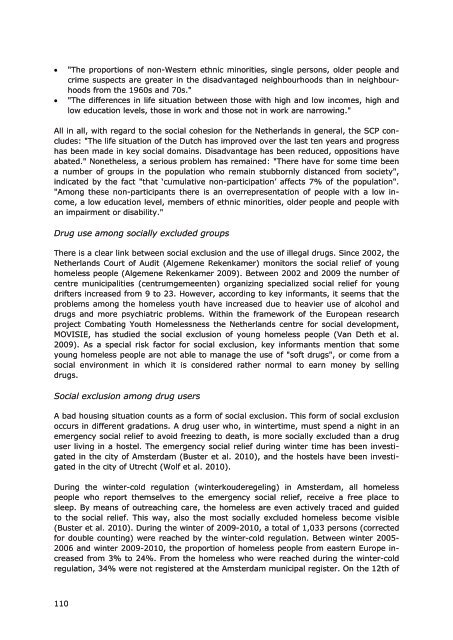The Netherlands Drug Situation 2010 - Trimbos-instituut
The Netherlands Drug Situation 2010 - Trimbos-instituut
The Netherlands Drug Situation 2010 - Trimbos-instituut
You also want an ePaper? Increase the reach of your titles
YUMPU automatically turns print PDFs into web optimized ePapers that Google loves.
"<strong>The</strong> proportions of non-Western ethnic minorities, single persons, older people andcrime suspects are greater in the disadvantaged neighbourhoods than in neighbourhoodsfrom the 1960s and 70s.""<strong>The</strong> differences in life situation between those with high and low incomes, high andlow education levels, those in work and those not in work are narrowing."All in all, with regard to the social cohesion for the <strong>Netherlands</strong> in general, the SCP concludes:"<strong>The</strong> life situation of the Dutch has improved over the last ten years and progresshas been made in key social domains. Disadvantage has been reduced, oppositions haveabated." Nonetheless, a serious problem has remained: "<strong>The</strong>re have for some time beena number of groups in the population who remain stubbornly distanced from society",indicated by the fact "that ‘cumulative non-participation’ affects 7% of the population"."Among these non-participants there is an overrepresentation of people with a low income,a low education level, members of ethnic minorities, older people and people withan impairment or disability."<strong>Drug</strong> use among socially excluded groups<strong>The</strong>re is a clear link between social exclusion and the use of illegal drugs. Since 2002, the<strong>Netherlands</strong> Court of Audit (Algemene Rekenkamer) monitors the social relief of younghomeless people (Algemene Rekenkamer 2009). Between 2002 and 2009 the number ofcentre municipalities (centrumgemeenten) organizing specialized social relief for youngdrifters increased from 9 to 23. However, according to key informants, it seems that theproblems among the homeless youth have increased due to heavier use of alcohol anddrugs and more psychiatric problems. Within the framework of the European researchproject Combating Youth Homelessness the <strong>Netherlands</strong> centre for social development,MOVISIE, has studied the social exclusion of young homeless people (Van Deth et al.2009). As a special risk factor for social exclusion, key informants mention that someyoung homeless people are not able to manage the use of "soft drugs", or come from asocial environment in which it is considered rather normal to earn money by sellingdrugs.Social exclusion among drug usersA bad housing situation counts as a form of social exclusion. This form of social exclusionoccurs in different gradations. A drug user who, in wintertime, must spend a night in anemergency social relief to avoid freezing to death, is more socially excluded than a druguser living in a hostel. <strong>The</strong> emergency social relief during winter time has been investigatedin the city of Amsterdam (Buster et al. <strong>2010</strong>), and the hostels have been investigatedin the city of Utrecht (Wolf et al. <strong>2010</strong>).During the winter-cold regulation (winterkouderegeling) in Amsterdam, all homelesspeople who report themselves to the emergency social relief, receive a free place tosleep. By means of outreaching care, the homeless are even actively traced and guidedto the social relief. This way, also the most socially excluded homeless become visible(Buster et al. <strong>2010</strong>). During the winter of 2009-<strong>2010</strong>, a total of 1,033 persons (correctedfor double counting) were reached by the winter-cold regulation. Between winter 2005-2006 and winter 2009-<strong>2010</strong>, the proportion of homeless people from eastern Europe increasedfrom 3% to 24%. From the homeless who were reached during the winter-coldregulation, 34% were not registered at the Amsterdam municipal register. On the 12th of110




